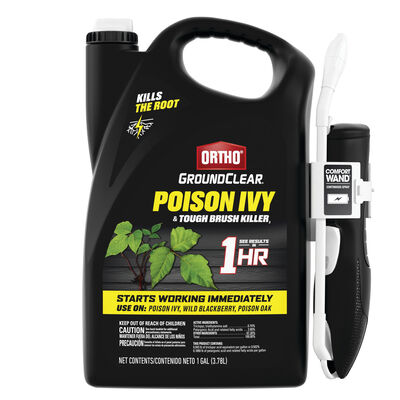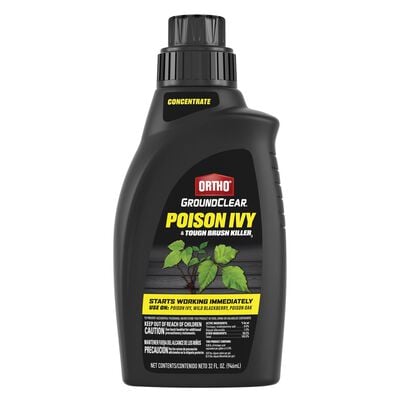
How to Kill Poison Ivy
Discover what works—and doesn’t work—in the fight to free your yard from this invasive weed.
Most people don't give poison ivy much thought. For those who do, it's usually because they've come in contact with it and have experienced an allergic reaction in the form of a red, blistery rash.
Fear of the rash, not to mention the hassle of dealing with it, can making discovering poison ivy in your landscape somewhat alarming. But while it's true that tackling this woody weed requires caution, with a little know-how, you can kill poison ivy safely. Here are some smart tips.
What Poison Ivy Looks Like
Is poison ivy a weed, a vine, or a shrub? Yes! When it comes to identifying poison ivy, it's important to know that it grows in all three of those forms.
The familiar refrain of "leaves of three, let it be" is a good rule thumb – but only a starting point. There are plenty of three-leaved plants that are not poison ivy, including box elder. On its own, having three leaves is not enough to positively mark a plant as poison ivy.
Here are a few more ways to identify poison ivy:
- The leaves of poison ivy are elliptical or egg-shaped.
- Poison ivy leaves can be smooth or have a sawtooth-like edge.
- Color-wise, poison ivy changes with the seasons. It's reddish in spring, green in summer, and yellow or reddish in autumn.
- Poison ivy's flowers are small, with five greenish-white petals.
- Its fruit, loved and spread by birds, are small, round, white, and waxy.
Where to Find Poison Ivy
Although poison ivy is a weed that can grow as a shrub, it most often grows as a vine. You may see it growing along fences, up buildings, and over and around fallen trees. It thrives in wooded environments under moist conditions; however, poison ivy also grows very well in dry conditions and suburban landscapes.
Other than in Alaska, Hawaii, and some parts of the West Coast, poison ivy is found throughout the United States. Its appearance varies from region to region, though, so it can look different from state to state.
Finally, while most people think of poison ivy as a summer weed, it actually grows in every season, including winter.
Allergic Reaction to Poison Ivy
The most notable thing about poison ivy is the allergic reaction it usually causes. That's because of a toxic, oily compound known as urushiol (u-ROO-she-ol). Urushiol is found in every part of the plant, and contact with it can lead to a nasty, itchy rash. It doesn't take much for poison ivy to exude this oily stuff, either. Crushing or bruising it will do, but so will merely brushing up against it.
While direct contact with another person's rash will not spread the rash, the urushiol itself can be spread from plant to person, person to person, and object to person (such as touching a garden tool that has come in contact with poison ivy).
How to Kill Poison Ivy Safely
What you'll need:
- Long pants, a long-sleeved shirt, and closed-toe shoes or boots
- Protective, disposable gloves
- Soap or over-the-counter poison ivy cleanser and water
- Pruning tools (optional)
- Heavy, disposable garbage bags that can be tightly sealed
- Herbicide formulated specially to kill poison ivy, like Ortho® GroundClear® Poison Ivy & Tough Brush Killer
Steps for Killing Poison Ivy:
- Choose a non-windy day when rain is not expected for at least 2 hours.
- Outfit yourself by covering as much exposed skin as possible. You also may want to wear goggles or safety glasses.
- Pull on a pair of disposable gloves and keep them on until you're done both treating the poison ivy and cleaning up.
- Though not essential, if the poison ivy plant is extremely large, you may want to prune it back a little. If you're not able to safely prune or simply don't want to, just move on to the next step.
- Apply a poison ivy control product that kills all the way to the root, such as Ortho® GroundClear® Poison Ivy & Tough Brush Killer. It's specially formulated to take out tough weeds, including poison ivy and poison oak. To use, spray mature leaves until thoroughly wetted.
- Allow time for the poison ivy to die. With Ortho® GroundClear® Poison Ivy & Tough Brush Killer, you'll see results in 24 hours, and wilting or yellowing in 2-4 weeks.
- Wear protective clothing and gloves when getting rid of dead poison ivy plants, as they still contain active urushiol. Remove them and carefully place them in a heavy garbage bag. Seal the bag tightly, and place the bags in an appropriate trash receptacle. Never burn poison ivy, as doing so will release urushiol into the air, where it can be breathed in—something that can be quite dangerous to humans.
Clean-Up Tips:
- While still wearing protective gloves, wash your shoes or boots off.
- Thoroughly wash all garden tools, including the handles.
- Pull on a pair of clean, disposable gloves and remove shoes and clothing. Immediately put them in the washer. Dispose of the gloves, then wash shoes and clothes in hot water with detergent. Do not add any other items.
- Take a warm-water shower. Don't take a bath since the urushiol can cling to bathtubs.
Why Digging Up Poison Ivy Doesn't Usually Work:
This method only works if the entire plant, including the root, is completely dug out. Unfortunately, poison ivy has a notoriously expansive root system—and leaving behind even the smallest portion of a root can lead to regrowth.
Helpful Reminders
- Know what poison ivy looks like so you can avoid direct contact with it.
- If you see a poison ivy plant or notice new growth, follow the steps above and treat it with Ortho® GroundClear® Poison Ivy & Tough Brush Killer.
- If a person or pet comes into contact with poison ivy, rinse the affected area with cold water as soon as possible. Follow up with a thorough washing for yourself using soap and water.
- Wash off anything and everything that comes in contact with poison ivy, including shoes, clothes, and tools.
Tackling a dreaded weed like poison ivy doesn't have to be tough, tricky, or time-intensive. These tips are designed to make it easy for you to know exactly what to look for—and what to do—to safely kill poison ivy.

